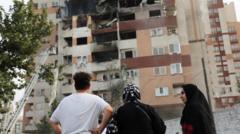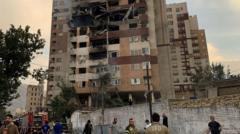Israel's recent military action against Iran was a culmination of years of intelligence gathering and strategic planning, conducted by military intelligence and Mossad, demonstrating the country's commitment to neutralizing perceived threats.
Israel's Intelligence Operations: The Strategic Strikes Against Iran

Israel's Intelligence Operations: The Strategic Strikes Against Iran
An in-depth look at Israel's intelligence-led military operations against Iran and its proxies.
June 13, 2025, 1:02 p.m. ET
Israel's large-scale military strike against Iran on Friday stemmed from years of meticulous intelligence operations focused on the nation’s nuclear capabilities, military figures, and scientific personnel. According to three unnamed Israeli sources familiar with the operations, the success of these operations relied heavily on pinpoint information regarding the movements of key officials and scientists.
The mission, dubbed “With the Strength of a Lion,” was a collaborative effort between Israeli military intelligence and Mossad. This operation underscores the significance of Israel's intelligence services in conducting various missions against Iran and its affiliates over the years.
Israel's record includes high-profile assassinations, such as the killing of Iran's nuclear chief, Mohsen Fakhrizadeh, via a remote-controlled device in 2020. Additionally, the Israeli intelligence community played a pivotal role in the elimination of Iranian Major General Qassim Suleimani in a U.S. drone strike, and the assassination of Colonel Sayad Khodayee, a senior member of Iran's Revolutionary Guards.
In 2022 and 2023, Israel escalated its operations by infiltrating Hezbollah, leveraging advanced communication technologies to execute coordinated attacks that saw high casualties amongst militia members. This culminated in substantial airstrikes, including the targeting of Hassan Nasrallah, the leader of Hezbollah.
In the latest strike on Iran, Israel's assault focused on key nuclear sites, air defense systems, missile storages, and other military installations. Although the specifics of the damage remain largely undisclosed, the Israeli military confirmed its assault on Iran's pivotal enrichment facility at Natanz, marking another significant escalation in the region's ongoing conflict.
Ronen Bergman is a staff writer for The New York Times Magazine, based in Tel Aviv.
Israel's large-scale military strike against Iran on Friday stemmed from years of meticulous intelligence operations focused on the nation’s nuclear capabilities, military figures, and scientific personnel. According to three unnamed Israeli sources familiar with the operations, the success of these operations relied heavily on pinpoint information regarding the movements of key officials and scientists.
The mission, dubbed “With the Strength of a Lion,” was a collaborative effort between Israeli military intelligence and Mossad. This operation underscores the significance of Israel's intelligence services in conducting various missions against Iran and its affiliates over the years.
Israel's record includes high-profile assassinations, such as the killing of Iran's nuclear chief, Mohsen Fakhrizadeh, via a remote-controlled device in 2020. Additionally, the Israeli intelligence community played a pivotal role in the elimination of Iranian Major General Qassim Suleimani in a U.S. drone strike, and the assassination of Colonel Sayad Khodayee, a senior member of Iran's Revolutionary Guards.
In 2022 and 2023, Israel escalated its operations by infiltrating Hezbollah, leveraging advanced communication technologies to execute coordinated attacks that saw high casualties amongst militia members. This culminated in substantial airstrikes, including the targeting of Hassan Nasrallah, the leader of Hezbollah.
In the latest strike on Iran, Israel's assault focused on key nuclear sites, air defense systems, missile storages, and other military installations. Although the specifics of the damage remain largely undisclosed, the Israeli military confirmed its assault on Iran's pivotal enrichment facility at Natanz, marking another significant escalation in the region's ongoing conflict.
Ronen Bergman is a staff writer for The New York Times Magazine, based in Tel Aviv.


















